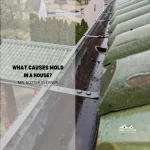Gutter end caps play a crucial role in home maintenance, serving as the final piece on gutter systems to prevent water from escaping the sides.
These components are essential for directing rainwater flow towards downspouts, ensuring effective water management around a home’s foundation. With various materials available, including aluminum and vinyl, homeowners can select gutter end caps that best suit their home’s architectural style and climatic conditions.
Proper installation and maintenance of these end caps are vital to avoid common issues such as leaks and blockages, which can lead to more significant problems like water damage and pest infestations.
By understanding the different types, benefits, and care practices for gutter end caps, homeowners can make informed decisions to protect their property and enhance its longevity.
This knowledge is fundamental for anyone looking to maintain their home’s gutter system efficiently, ensuring it functions correctly to safeguard the structure from water-related issues.
Selecting the right gutter end caps not only contributes to the aesthetic appeal of a home but also plays a significant role in its protection against weather elements, making it a critical consideration for effective home maintenance.
Understanding Gutter End Caps
Gutter end caps are integral components of a home’s gutter system, designed to seal the ends of gutters. Their primary purpose is to prevent water from escaping the sides, ensuring that rainwater is efficiently channeled towards downspouts. This functionality is vital for the effective management of rainwater, protecting the home’s foundation and landscaping from water damage.
Additionally, gutter end caps play a significant role in keeping debris, leaves, and pests out of the gutter channels, facilitating smoother water flow and reducing maintenance needs. Understanding the role and benefits of gutter end caps is crucial for homeowners looking to enhance their home maintenance practices and ensure the longevity of their gutter systems.
Purpose and Functionality
Gutter end caps seal the gutter system’s ends, directing water towards downspouts and preventing spillage. They play a key role in home maintenance by ensuring efficient water flow and protecting the structure from water damage. By keeping out debris and pests, gutter end caps also contribute to the longevity and effectiveness of the gutter system.
Types and Materials
Gutter end caps are available in various materials, including aluminum, vinyl, and copper, each offering distinct advantages. Aluminum end caps are lightweight and resistant to corrosion, making them a popular choice for durability and low maintenance. Vinyl end caps, known for their ease of installation and cost-effectiveness, suit budget-conscious homeowners. Copper end caps, while more expensive, add an aesthetic appeal and exceptional longevity to gutter systems, aging gracefully with a patina that protects against corrosion. Choosing the right material depends on the homeowner’s priorities, including durability, budget, and aesthetic preferences.
Importance of Gutter End Caps for Home Maintenance
Gutter end caps are not just accessories; they are a fundamental component in safeguarding a home from the potential damages caused by uncontrolled water flow. These small yet significant pieces cap off the gutter system, ensuring that water is directed away from the house and into designated drainage areas. This functionality is critical in maintaining the structural integrity of a home’s foundation.
Protecting the Home’s Foundation
The foundation is the bedrock of a home’s stability. Gutter end caps play a pivotal role in protecting this foundation by preventing water from spilling over the gutter edges. Without these caps, water can pool around the base of the home, leading to soil erosion, weakened foundation materials, and ultimately, structural issues. By efficiently managing rainwater, gutter end caps mitigate the risk of foundational erosion and safeguard the home’s structural integrity.
Preventing Water Damage and Leaks
Beyond the foundation, gutter end caps contribute significantly to preventing water damage and leaks within the home. By containing water within the gutters and directing it towards downspouts, these caps help avoid scenarios where water infiltrates the roof, walls, or basement. Unchecked, water ingress can lead to mold growth, rot, and interior damage, which are not only costly to repair but can also pose health risks. Gutter end caps, therefore, are essential in maintaining a dry and damage-free home environment.
Selecting the Right Gutter End Caps
Choosing the appropriate gutter end caps is a crucial decision in maintaining a home’s gutter system. This choice impacts not only the functionality of the gutters but also the aesthetic appeal of the home’s exterior. Homeowners must consider several factors to ensure their selection enhances the gutter system’s performance and durability.
Factors to Consider
When selecting gutter end caps, homeowners should evaluate the material, size, and design of the end caps. The material should be compatible with the existing gutter system to ensure longevity and prevent corrosion. Size is critical; the end caps must fit snugly to avoid leaks.
The design should complement the home’s architectural style, offering both functionality and visual appeal. Additionally, considering the local climate can guide the material choice, as some materials perform better in specific weather conditions.
Compatibility with Gutter Systems
The compatibility of gutter end caps with the gutter system is paramount. End caps are not one-size-fits-all; they must match the gutter profile to create a seamless and leak-proof closure.
Homeowners should verify the compatibility of the end caps with their gutter system, whether it be K-style, half-round, or another type. This ensures a proper fit that prevents water leakage and debris accumulation, safeguarding the home from water damage efficiently.
Installation Guide for Gutter End Caps
Installing gutter end caps is a straightforward process that homeowners can undertake to ensure their gutter system functions optimally. Proper installation prevents water from leaking at the gutter ends, directing it towards downspouts as intended. This section outlines the necessary steps and considerations for a successful installation.
DIY Installation Steps
Measure and Purchase: Begin by measuring the gutter end where the cap will be installed to ensure a precise fit. Purchase the appropriate size and material of gutter end caps that match your existing gutter system.
- Prepare the Area: Clean the gutter end thoroughly, removing any debris, leaves, or sediment. This ensures a clean surface for the end cap to adhere to.
- Apply Sealant: Apply a bead of waterproof sealant along the inner edge of the gutter end cap. This enhances the watertight seal, preventing leaks.
- Fit the End Cap: Carefully place the end cap onto the gutter end, ensuring it fits snugly. Press firmly to secure the cap in place.
- Secure with Screws: For added stability, secure the end cap with screws. Drill the screws through the designated holes in the end cap into the gutter end.
- Seal Edges: Apply additional sealant along the edges where the end cap meets the gutter to reinforce the seal. Smooth out the sealant with a spatula for a clean finish.
- Inspect: Finally, inspect the installation to ensure the end cap is securely in place and there are no gaps or potential leak points.
When to Hire a Professional
While DIY installation of gutter end caps is achievable, certain situations warrant professional assistance. Consider hiring a professional if:
- Complex Gutter Systems: Your gutter system has a complex design or hard-to-reach areas that make DIY installation challenging.
- Safety Concerns: The gutters are located at a height or position that poses a safety risk without the proper equipment and experience.
- Material Compatibility: You are unsure about the compatibility of the end caps with your gutter material or require custom solutions.
- Guaranteed Quality: You prefer the assurance of a professional installation to guarantee the work’s quality and durability.
Professionals can also provide valuable insights into maintaining your gutter system and may identify issues that untrained eyes might miss. Investing in professional installation can ensure the longevity and effectiveness of your gutter system, protecting your home from water-related damages efficiently.
Maintenance Tips for Gutter End Caps
Regular maintenance of gutter end caps is essential for ensuring the gutter system’s longevity and functionality. Proper care prevents buildup of debris and water, which can lead to damage over time. This section provides homeowners with practical advice on maintaining their gutter end caps to keep their gutter systems operating efficiently.
Routine Cleaning and Inspection
Regular cleaning and inspection of gutter end caps are vital for preventing clogs and ensuring water flows smoothly through the gutter system. Homeowners should:
- Inspect gutter end caps seasonally: Check for signs of wear, damage, or loosening. The best times for inspection are before and after severe weather seasons.
- Clean gutters and end caps twice a year: Remove leaves, twigs, and debris that can accumulate and cause blockages. A garden hose, gutter cleaning tool, or a hand trowel can be effective for this task.
- Check for leaks: Look for any water escaping from the edges of the end caps, which could indicate a poor seal or damage.
Addressing Common Issues
- Even with regular maintenance, common issues with gutter end caps can arise. Homeowners should be prepared to address these problems to prevent further damage:
- Loose end caps: Over time, gutter end caps may become loose. If they’re still in good condition, reattach them using a suitable sealant and possibly new screws for a secure fit.
- Corrosion or wear: Metal gutter end caps, especially those made of aluminum or steel, can corrode or wear down. If corrosion is significant, replace the end caps to maintain the gutter’s integrity.
- Sealant failure: The sealant used to attach and seal end caps can degrade. Check the sealant’s condition during inspections and reapply as necessary to ensure a watertight seal.
- Maintaining gutter end caps is straig
Troubleshooting and Repairing Gutter End Caps
Effective troubleshooting and repairing of gutter end caps are crucial to maintaining a home’s gutter system’s functionality. Over time, end caps may develop issues that can compromise the gutter system’s effectiveness, leading to potential water damage. This section outlines common problems and their solutions, empowering homeowners with the knowledge to keep their gutter systems in optimal condition.
Identifying Common Problems
Several signs indicate issues with gutter end caps, including visible leaks, water stains on siding or foundation, and detached or missing end caps. Regular inspections can help identify these problems early, preventing more significant issues. Homeowners should look for:
- Leaks at the end cap seams: Indicative of sealant failure or improper installation.
- End caps becoming loose or falling off: This can result from weather-related expansion and contraction, improper fitting, or wear and tear.
- Water overflow near the end cap: Suggests a blockage or misalignment that prevents water from flowing smoothly to the downspout.
DIY Fixes vs. Professional Repairs
DIY Fixes:
- Resealing End Caps: If leaks occur at the seams, applying a new layer of waterproof sealant can often resolve the issue. Ensure the area is dry and clean before application.
- Reattaching Loose End Caps: For end caps that have become loose, reattach them using appropriate screws or clips, and seal the edges with gutter sealant to prevent leaks.
- Clearing Blockages: Remove any debris causing blockages at the end cap, ensuring water can flow freely towards the downspout.
Professional Repairs:
- Complex Issues: If the gutter system has significant damage or if the homeowner is unsure of the repair’s extent, it’s best to consult a professional. They can assess the system comprehensively and perform necessary repairs or replacements.
- Safety Concerns: For gutters that are high off the ground or difficult to access, hiring a professional ensures repairs are done safely and effectively.
- Warranty Considerations: Some gutter systems have warranties that might be voided by DIY repairs. In such cases, professional service is advisable.


